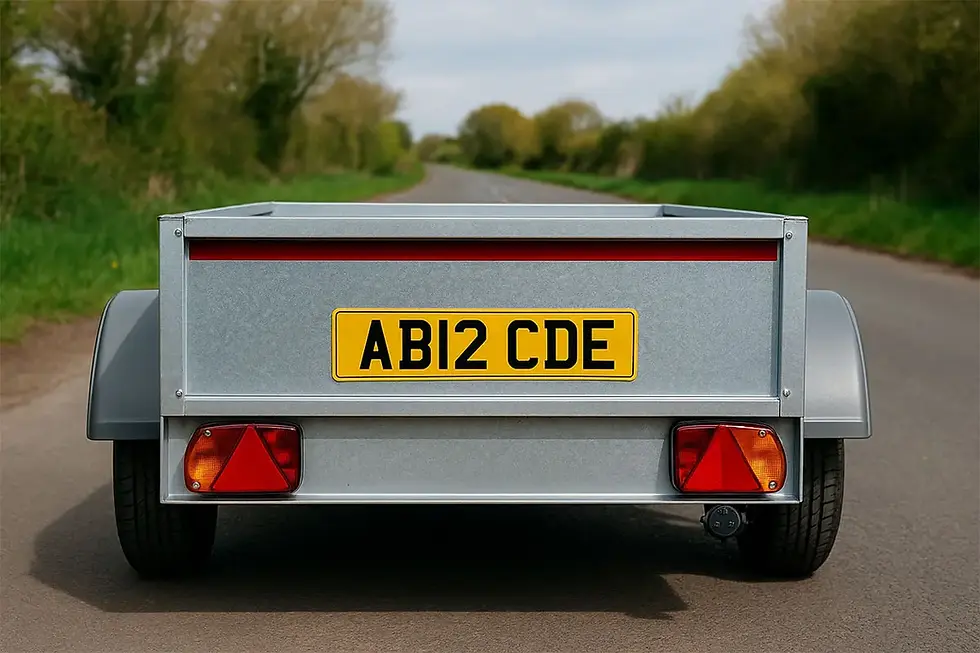Trailer Number Plates: Learn UK trailer number plates laws
- Brent

- Oct 1
- 3 min read
Every trailer on the road needs a visible, legible number plate — and while it might sound like a simple rule, many drivers still get caught out by incorrectly fitted, poor visibility, or obscured plates.
Here’s what UK law actually says about trailer number plates, where to fit them, and how to stay compliant when towing.
The Legal Basis
The display of number plates is governed by Statutory Instrument 1971 No. 450 — The Road Vehicles (Registration & Licensing) Regulations 1971, specifically Part III: Exhibition of Licences and Registration Marks.
These rules apply to all vehicles — except works trucks and agricultural machines — first registered on or after 1 October 1938. That includes every road-legal trailer used behind cars, vans, and lorries today.
Visibility Requirements
To comply with the law, your trailer’s registration mark (number plate) must be:
Fixed and displayed at the rear of the trailer
Easily legible in normal daylight
Readable from every part of what’s called the “relevant area”
What Is the Relevant Area?
The “relevant area” refers to a square on the ground behind the vehicle, where:
One corner of the square is directly below the middle of the number plate
The diagonal of the square runs 75 feet from that corner, parallel to the vehicle’s length
Any area within 10 feet of the vehicle is excluded
In short, your number plate must be clearly readable from up to 75 feet away, from directly behind and at an angle.
If your number plate is faded, bent, covered by mud, or obscured by your towbar or lighting board, you’re breaking the law.
Fixed Penalty Offences
Allowing your trailer’s number plate to be obscured or unreadable is now a fixed penalty offence. That means you can be fined on the spot — and it’s far more likely to be enforced under current police guidelines.
Towbar fitters and anyone towing with detachable hitches, racks, or light boards should be particularly careful.
Your number plate must be visible at all times when towing. If you fit an accessory that blocks it, you must display a duplicate plate on the rear of the trailer or light board.

Number Plate Format and Material
All trailer number plates must:
Display the same registration number as the towing vehicle
Be made from reflective material
Have black characters on a white background (rear plates can be yellow if preferred)
Use approved fonts and spacing
Plates should be securely mounted and free from cracks, fading, or damage that could reduce legibility.
After Brake Overheating: Check Bearings and Grease
It’s worth noting that after any instance of brake overheating, it’s essential to check your wheel bearings and grease. Heat can quickly degrade lubrication, leading to bearing failure — which can cause wheels to seize or detach. Replace bearings and grease immediately if there’s any sign of damage or contamination.
Brent’s Take
At Brent, we know that number plates often get overlooked — until they attract a fine. Keeping your trailer plate clean, visible, and properly fitted is one of the simplest ways to stay legal on the road.
Before every tow, run a quick checklist:
Is the plate clearly visible and securely fixed?
Is it clean and undamaged?
Is it the correct registration for your towing vehicle?
If your trailer needs a fresh start, you’ll find road-legal, fully compliant trailers on Brent — complete with proper lighting, couplings, and number plate fittings.
Brent — built for safety, compliance, and confidence on every tow.
-BRENT




Comments